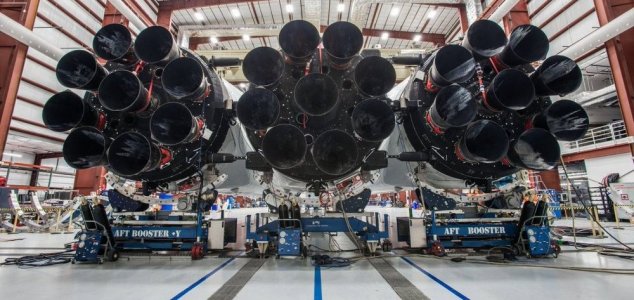Space & Astronomy
January 29, 2018 · 86 comments
86 comments

SpaceX is set to make history in just over one weeks' time. Image Credit: SpaceX / Elon Musk
Like the Falcon 9, each of the boosters are reusable and will land again after each launch, helping to keep costs down and to reduce the buildup of space debris in Earth's orbit.
The rocket will be lifting off from the historic Launch Pad 39A ( the same pad from which the Apollo Moon missions launched ) at NASA's Kennedy Space Center in Cape Canaveral, Florida.
It will be carrying perhaps the most unusual payload of any major launch - Musk's Tesla Roadster - with the aim of placing it in to a heliocentric orbit that will eventually take it very close to Mars.
Musk himself has warned however that there is no guarantee that the launch will be a success.
"There's a lot that could go wrong there," he said. "I encourage people to come down to the Cape to see the first Falcon Heavy mission; it's guaranteed to be exciting."
Source: Space.com | Comments (86)
Falcon Heavy set to launch on February 6th
By T.K. RandallJanuary 29, 2018 ·
 86 comments
86 comments
SpaceX is set to make history in just over one weeks' time. Image Credit: SpaceX / Elon Musk
The first test launch of Elon Musk's next generation rocket is set to take place in just over a week.
The Falcon Heavy, which consists of a strengthened Falcon 9 rocket core with two additional Falcon 9 boosters on either side, is the company's first super heavy-lift launch vehicle.Like the Falcon 9, each of the boosters are reusable and will land again after each launch, helping to keep costs down and to reduce the buildup of space debris in Earth's orbit.
The rocket will be lifting off from the historic Launch Pad 39A ( the same pad from which the Apollo Moon missions launched ) at NASA's Kennedy Space Center in Cape Canaveral, Florida.
Musk himself has warned however that there is no guarantee that the launch will be a success.
"There's a lot that could go wrong there," he said. "I encourage people to come down to the Cape to see the first Falcon Heavy mission; it's guaranteed to be exciting."
Source: Space.com | Comments (86)

The Unexplained Mysteries
Book of Weird News
AVAILABLE NOW
Take a walk on the weird side with this compilation of some of the weirdest stories ever to grace the pages of a newspaper.
Click here to learn more

Support us on Patreon
BONUS CONTENTFor less than the cost of a cup of coffee, you can gain access to a wide range of exclusive perks including our popular 'Lost Ghost Stories' series.
Click here to learn more
Extraterrestrial Life and The UFO Phenomenon
Spirituality, Religion and Beliefs
United States and the Americas
Conspiracies and Secret Societies
Total Posts: 7,603,721 Topics: 316,234 Members: 201,807
Not a member yet ? Click here to join - registration is free and only takes a moment!
Not a member yet ? Click here to join - registration is free and only takes a moment!



























Please Login or Register to post a comment.